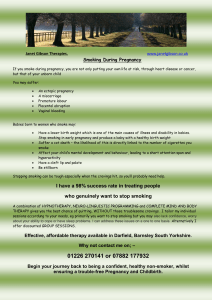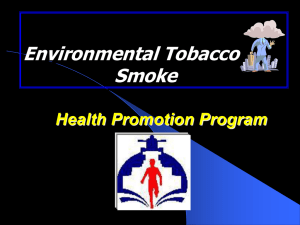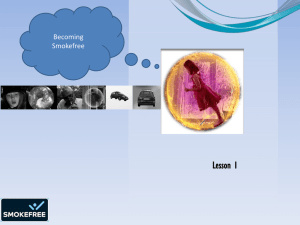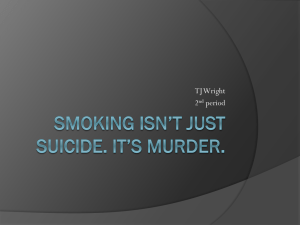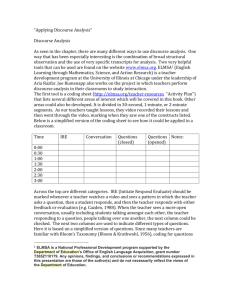reasearch paper - bsuenglish103
advertisement
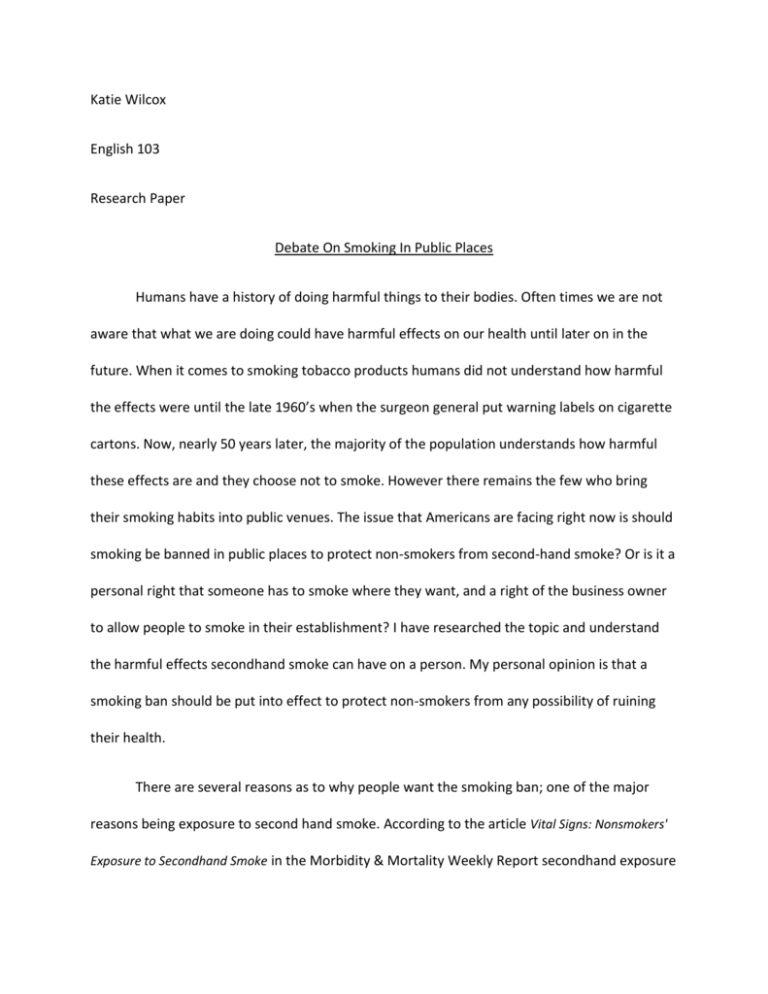
Katie Wilcox English 103 Research Paper Debate On Smoking In Public Places Humans have a history of doing harmful things to their bodies. Often times we are not aware that what we are doing could have harmful effects on our health until later on in the future. When it comes to smoking tobacco products humans did not understand how harmful the effects were until the late 1960’s when the surgeon general put warning labels on cigarette cartons. Now, nearly 50 years later, the majority of the population understands how harmful these effects are and they choose not to smoke. However there remains the few who bring their smoking habits into public venues. The issue that Americans are facing right now is should smoking be banned in public places to protect non-smokers from second-hand smoke? Or is it a personal right that someone has to smoke where they want, and a right of the business owner to allow people to smoke in their establishment? I have researched the topic and understand the harmful effects secondhand smoke can have on a person. My personal opinion is that a smoking ban should be put into effect to protect non-smokers from any possibility of ruining their health. There are several reasons as to why people want the smoking ban; one of the major reasons being exposure to second hand smoke. According to the article Vital Signs: Nonsmokers' Exposure to Secondhand Smoke in the Morbidity & Mortality Weekly Report secondhand exposure to tobacco smoke has been proven to cause heart disease and lung cancer in nonsmoking adults and sudden infant death syndrome, acute respiratory infections, middle ear disease, exacerbated asthma, respiratory symptoms, and decreased lung function in children. With that said nearly all nonsmokers who live with someone who smokes inside their home are exposed to secondhand smoke. The article clearly stated that the only way to eliminate the possibility of being exposed to health concerns caused by secondhand smoke is to ban smoking in public places. According to the American Journal of Health, exposure to secondhand smoke (also known as involuntary smoking, environmental smoking, and passive smoking) technically is a mixture of gases and particles from burning cigarettes and cigars, and essentially is the smoke leftover that the smoker did not inhale. The smoke that the smoker does inhale is called mainstream smoke. Mainstream and secondhand smoke have the same amount of harmful gases and particles within them. It is said that secondhand smoke in non-smokers can cause lung cancer, cervical cancer, nasal sinus cancer, and heart disease. Stroke, asthma, and eye and nasal irritation have also been associated with secondhand smoke. In fewer, but still serious cases breast cancer, angina pectoris, pneumonia, hearing loss, allergies, colds, meningococcal disease, congestive heart failure, and cardiac arrhythmia have all been reported. With children exposed to secondhand smoke, low birth weight, sudden infant death syndrome (SIDS), chronic respiratory symptoms, and cystic fibrosis exacerbation have all been recorded (Zollinger 1). The California Air Resources Board (CARB), a department of the California Environmental Protection Agency, has released a report that links environmental tobacco smoke (ETS) to a variety of health effects. In addition, it has conducted research that reveals how much pollution secondhand smoke can add to the air. In California each year, tobacco smoke is responsible for the release of 40 tons of nicotine, 365 tons of chemical particles, and 1,907 tons of carbon monoxide (Secondhand 1). Some bar owners are not happy about the smoking ban because they think it will cause them to lose a significant amount of their business. This claim has been disproved in a town in Arizona. In the city of Flagstaff on May 1, 2005 a smoking ban was put into effect in bars. Trained observers carried air monitoring equipment and counted fit cigarettes and customers in the bars on two weekends before and four weekends after the smoking ban went into effect. Monthly hospitality revenues from 2003 to 2006 were also collected from the Coconino County Tax Assessor's office and analyzed for changes after the ban. Air quality apparently improved immediately by 87% in bars where the ban was in place, with no noticeable drop in the total bar revenues over the next three years. As a whole, bar revenue was not affected by the smoking ban. The revenue actually continued to increase after the ban (Menke 1). When families go out into town to spend time together breathing in harmful particles is the last thing on their minds. Most Americans understand that secondhand smoke is harmful, but they probably do not realize the extent as to how destructive it can be. When these facts are presented it hopefully triggers fear in minds of parents especially. When they take their kids to a restaurant do they know how much pollution their child is breathing in? Smokers in the restaurant also may not know how harmful their habit can be to the people around them; in public or not. Families should not have to worry about their health while trying to have a nice time in public. Yes this is America and it is a free country, but putting the health of those around a smoker should be where the line is drawn. The only way that non-smokers will be free from this dilemma is to place a ban on smoking tobacco in public places. It will free all worries about putting the health of young children, pregnant women, and the elderly in jeopardy. Not only the most vulnerable people, but the healthy people as well. It is unlikely that they want to ruin their health because they were at public places frequently that allowed smoking. Smoking rights would not be taken away; people could smoke on the street by their car or in the parking lots, and of course, in their own homes. They can ruin their own health, but this ban would make it possible to protect the health of the innocent. Works Cited Kaufmann, R. B., et al. "Vital Signs: Nonsmokers' Exposure to Secondhand Smoke -- United States, 19992008." MMWR: Morbidity & Mortality Weekly Report 59.35 (2010): 1141-1146. Academic Search Premier. EBSCO. Web. 31 Oct. 2010. Menke, J. Michael, and J. MICHAEL MENKE. "BAR PATRONAGE AFTER A SMOKING BAN." Journal of Drug Issues 39.2 (2009): 401-415. Academic Search Premier. EBSCO. Web. 7 Nov. 2010. "Secondhand Smoke Linked to Health Risks in Children and Women." Journal of Environmental Health 68.6 (2006): 78-79. Academic Search Premier. EBSCO. Web. 31 Oct. 2010. Zollinger, Terrell W., et al. "Estimating the Economic Impact of Secondhand Smoke on the Health of a Community." American Journal of Health Promotion 18.3 (2004): 232-238. Academic Search Premier. EBSCO. Web. 31 Oct. 2010. Katie Wilcox Debate On Smoking In Public Places Cover Letter The intent of my research paper is to give reasonable explanations as to why smoking should be banned in public places. I wanted my readers to be presented with information that would help them understand the harmful effects of secondhand smoke. I also wanted to present the opposite opinion and explain why there are things wrong with it. I started brainstorming with Carlye and Chip. We decided from what point of views we were going to write from. From there we started looking for sources. It was difficult to find reliable sources that had an abundance of information that we could use. Eventually we found some that would work, and I began writing my paper. For my rough draft I had trouble making things fit together to make sense. I also had trouble making my sources for the opposite opinion work. I couldn’t draw complete thoughts that made sense, so I just ended up not including that part in my rough draft. Now that my paper is done I can read through it and I believe I have presented my opnion well and supported it with substantial research. When I was revising Rosie told me to add more information to the opposing opinion of my topic. She also said that she thought I organized my thoughts well. Writing this paper has helped me to understand the research process better. I feel confident that I can write better research papers in the future now. I also know that it is important to include the opposing opinion in your papers. It can strengthen your side of the argument if you do the research correctly.


